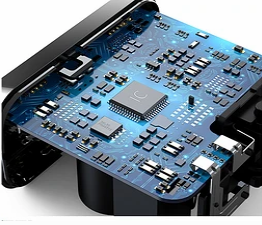For microwave-level high-frequency circuits, each corresponding strip line on the PCB forms a microstrip line with the ground plate (asymmetrical). For PCBs with more than two layers, the microstrip line can be formed, and the strip line can be formed ( Symmetrical microstrip transmission line). Different microstrip lines (double-sided PCB) or strip lines (multi-layer PCB) form a coupled microstrip line between each other, which in turn forms a variety of complex four-port networks, thus forming each of the microwave-level circuit PCBs. This characteristic law.
It can be seen that the theory of microstrip transmission lines is the basis for the design of microwave-level high-frequency circuit PCBs.
▪ For RF-PCB design above 800MHz, the PCB network design near the antenna should fully follow the theory of microstrip (not just use the microstrip concept as a tool to improve the performance of lumped parameter devices). The higher the frequency, the more significant the guiding significance of the microstrip theory.
▪ For the centralized and distributed parameters of the circuit, although the lower the operating frequency, the weaker the effect of the distributed parameters, but the distributed parameters always exist.

Whether to consider the influence of distributed parameters on circuit characteristics, there is no clear dividing line. Therefore, the establishment of the microstrip concept is equally important for the digital circuit and relative intermediate frequency circuit PCB design.
▪ The basis and concept of microstrip theory and the concept of microwave-level RF circuit and PCB design are actually an application aspect of microwave dual transmission line theory. For RF-PCB wiring, every adjacent signal line (including neighboring on different sides) is Form features that follow the two-line basic principle (this will be clearly explained in the follow-up).
▪ Although the usual microwave RF circuit is equipped with a ground plate on one side, the microwave signal transmission line on it tends to a complex four-port network, which directly follows the coupled microstrip theory, but its basis is still the two-wire theory. Therefore, in design practice, the guiding significance of the two-line theory is more extensive.
▪ Generally speaking, for microwave circuits, microstrip theory has a quantitative guiding significance and belongs to a specific application of the two-wire theory, while the two-wire theory has a broader qualitative guiding significance.
▪ It is worth mentioning that: on the surface, all the concepts given by the two-wire theory seem to have nothing to do with actual design work (especially digital circuits and low-frequency circuits), but they are actually an illusion. Two-wire theory can guide all conceptual issues in electronic circuit design, especially the significance of PCB circuit design concepts.
Although the two-wire theory is established under the premise of microwave high-frequency circuits, it is only because the influence of distributed parameters in high-frequency circuits has become significant, which makes the guiding significance particularly prominent. In digital or medium and low frequency circuits, the distributed parameters are negligible compared with lumped parameter components, and the concept of two-wire theory becomes correspondingly fuzzy.
However, how to distinguish between high-frequency and low-frequency circuits is often overlooked in actual design. What kind of general digital logic or pulse circuit belong to? The most obvious low-frequency circuits and low-frequency circuits with nonlinear components, once some sensitive conditions change, it is easy to reflect certain high-frequency characteristics. The main frequency of high-end CPU has reached 1.7GHz, far exceeding the lower limit of microwave frequency, but it is still a digital circuit. Because of these uncertainties, PCB design is extremely important.
▪ In many cases, the passive components in the circuit can be equivalent to a transmission line or microstrip line of a specific specification, and can be described by the dual transmission line theory and its related parameters.
In short, it can be considered that the dual transmission line theory was born on the basis of integrating the characteristics of all electronic circuits. Therefore, in a strict sense, if every aspect of the design practice is based on the concept embodied in the dual transmission line theory, then the corresponding PCB circuit will face few problems (no matter what the circuit is working in) Under conditions)